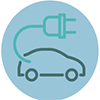
Homeowners unlock federal energy-efficiency rebates, influencing market trends.
The housing market stands on the verge of a significant transformation, driven by evolving sustainability trends that are reshaping buyer preferences and home construction standards. In fact, the 2023 National Association of REALTORS®’ Sustainability Report for the residential sector highlights the consistent demand for energy-efficient features, transcending the North-South or red-blue state divide.
Angi, the home improvement website, asked homeowners about their major investment plans for the next five years. While traditional projects such as bathroom remodeling and basement refinishing remain popular, the Angi survey showed a growing interest in new projects, such as heating and cooling system upgrades and the installation of solar panels. Notably, a ratio of 1 in 3 homeowners is considering solar panel installation, and 1 in 4 is planning a heating and cooling system upgrade.
New building codes aimed at enhancing energy efficiency and reducing household energy consumption have also had an impact on market transformation.
Between 2006 and 2015, newly constructed residential buildings saw a nearly 30% improvement in energy efficiency due to updated building code requirements, according to the U.S. Department of Energy’s Building Energy Codes Program. Since 2009, almost every state has updated its building codes, contributing to significant reduction in energy usage. (See energycodes.gov/infographics.(link is external))
Unlocking Funds for Sustainable Home Enhancements

The Inflation Reduction Act, passed in August 2022, is expected to greatly accelerate this market shift through its home energy rebate program. It heralds a new chapter in property ownership and investment practices. The act allocates a substantial $8.8 billion for programs encouraging homeowners to enhance the efficiency of their homes through two primary initiatives.
1. High-Efficiency Electric Home Rebate Act (HEEHR)
This program allocates $4.5 billion to individual states to help low- and moderate-income residents create energy-efficient homes, save on monthly utilities, and lower their carbon footprints. Through point-of-sale rebates on electrification appliances and equipment, the act offers 100% rebates (up to $14,000) on electrification projects for low-income households and 50% rebates (also to $14,000) for moderate-income households.
Some items included in these rebates are:
- Heat pump HVAC systems
- Heat pump water heaters
- Heat pump clothes dryers
- Electric stoves and cooktops
Also included are “enabling measures” for projects such as upgrading ventilation, circuit panels, air sealing, insulation and wiring.
2. Homeowner Managing Energy Savings Program (HOMES)
This program allocates $4.3 billion under HEEHR to individual states’ energy offices. Funds through the program are available to every household regardless of income; however, low- and moderate-income homes are eligible for higher rebates. Also, like HEEHR, this allocation is designed to provide rebates to help Americans create more energy-efficient homes—but that’s where the similarities stop.
Unlike HEEHR, HOMES doesn’t provide point-of-sale rebates on equipment purchases. Instead, it offers rebates based on modeled or actual home performance. There are two paths for rebates through the HOMES program.
First, the modeled-performance pathway calculates rebates based on the projected ability of an improvement to increase a home’s energy efficiency compared to its historic usage.
Contractors or other program implementers will use energy modeling software to establish an initial baseline for a home’s energy consumption and to propose a new energy model depending on the type of retrofit the homeowners have undertaken and their home’s historical energy usage. How much of a rebate can homeowners expect from this model?
For low- and moderate-income homes:
- Retrofits that achieve energy system savings of at least 20% but less than 35% are eligible for the lesser of $4,000 or 80% of the project cost.
- Retrofits that achieve energy system savings of at least 35% are eligible for the lesser of $8,000 or 80% of the project cost.
For high-income homes:
- Retrofits that achieve energy system savings of at least 20% but less than 35% are eligible for the lesser of $2,000 or 50% of the project cost.
- Retrofits that achieve energy system savings of at least 35% are eligible for the lesser of $4,000 or 50% of the project cost.
It’s worth noting that projects that result in energy savings of less than 20% are not eligible for rebates, regardless of cost.
Alternatively, the measured-performance pathway provides rebates based on a home’s actual energy performance. These rebates require the use of an approved open-source measurement and verification software to measure and verify a home’s energy savings based on historical and future utility bills. Homeowners still get their rebate upfront, most likely through an aggregator, who is in turn paid once the savings are demonstrated.
For low- and moderate-income homes:
- Retrofits that achieve energy system savings of at least 15% are eligible for a rebate that’s based on the number of kilowatt hours saved.
- Rates will be set at the state level based on the energy usage of an “average home” in that state.
- Or, rebates may be issued for up to 80% of the project cost.
For high-income homes:
- Retrofits that achieve energy system savings of at least 15% are eligible for a rebate that’s based on the number of kilowatt hours saved.
- Rates will be set at the state level based on the energy usage of an “average home” in that state and will be lower than the rates for low- and moderate-income homes on a per kilowatt hour basis.
- Or, rebates may be issued for up to 50% of the project cost.
If the actual savings resulting from an improvement is less than 15%, the home-owners aren’t eligible for a rebate. Also, the bill itself does not specify that homeowners pursuing measured-performance rebates are automatically given the lesser of the amounts above, but it may be wise to operate under that assumption.
Clean Energy Tax Credit (Code 25D)

Also stemming from the 2022 Inflation Reduction Act is an array of tax credits designed to promote the use of clean and efficient energy sources by homeowners. (Visit energy.gov/eere/solar.(link is external)) Fortunately, the credits are all much simpler to understand than the rebates available through HEEHR and HOMES.
Under Code 25D, between now and 2032, homeowners can qualify for a 30% tax credit on purchases of or expenditures related to qualified:
- Solar electricity generators
- Solar water heaters (if at least half of the energy used in the home comes from the sun)
- Fuel cells and battery storage with a capacity of at least three kilowatt hours
- Small wind energy generators
- Geothermal heat pumps that meet Energy Star requirements
Heads up to homeowners: Act sooner rather than later, because the credit begins to shrink starting in 2033. It drops to 26% that year and 22% the following year.
Energy-Efficient Home Improvement Tax Credits

Like the credits available via Code 25D, the credits offered through Code 25C are easy to understand and relatively easy to qualify for. Homeowners who make efficiency upgrades, such as better insulation and improved heating equipment, can claim a rebate of up to $1,200 or 30% of project costs on their annual tax returns.
Furthermore, homeowners who install heat pumps can claim up to $2,000, and another $600 is available for homeowners who make upgrades to their electrical panels. Lastly, homeowners who coordinate with their utility provider to conduct a home energy audit (sometimes called a “home energy assessment”) can claim an additional tax credit of $150.
In total, homeowners can claim up to $3,200 in energy-efficient home improvement tax credits each year.
EV Charging Station Tax Credit

Through the electric vehicle charging station tax credit (Code 30C), owners of alter- native fuel vehicles can claim a healthy tax credit when installing charging stations on their property. (Visit afdc.energy.gov to learn more.) Starting on Jan. 1, 2023, installing fueling equipment for alternative fuel vehicles—including natural gas, propane, hydrogen, electricity, E85, or diesel fuel blends containing a minimum of 20% biodiesel—began earning homeowners a tax credit of 30% of the cost of the installation project, or 6% of the project cost in the event that the property is subject to depreciation.
However, there are limitations. No matter what the cost of the installation is, home-owners can claim a maximum of $100,000 for each single item of property. Keep in mind that associated costs, like permitting and inspection fees, aren’t included in total expenses.
A charging cable that plugs into a 220-volt outlet doesn’t qualify as a charging station, according to the IRS. In other words, a charging station must be a permanent fixture at the location where the EV is charged. Additional qualifying language from IRS Form 8911 notes that to qualify for the credit, a charging station must meet the following conditions:
- The homeowner placed the refueling property in service during that tax year.
- The original use of the property began with the homeowner.
- The refueling property isn’t used predominantly outside the United States.
- If the refueling property isn’t for business or investment use, it must be installed on property used as your main home.
- Property placed in service after 2022 must be located in an eligible census tract.
Optimizing Savings With State and Local Incentives

Households stand to gain even more when they combine the rebates and tax credits availablethroughthe Inflation Reduction Act with rebates and incentives from state and utility programs. As of October 2023, DOE Home Energy Rebate guidance says the HOMES and HEEHR programs aren’t taxable and can be paired with the 25C Energy Efficient Home Improvement tax credit for certain upgrades. Although the Inflation Reduction Act doesn’t permit the simultaneous use of HOMES and HEEHR to finance a single upgrade, it does allow homeowners to combine these rebates across various federal funding sources, such as the Weatherization Assistance Program, a DOE program that focuses on retrofits for insulation, heating and cooling systems, and electrical appliances, with an emphasis on addressing the “whole home.” Each federal grant must be allocated exclusively for distinct and separable upgrades. For example, a household can’t get a rebate from the WAP and IRA for the same heat pump upgrade.
Accessing Funding Opportunities

Currently, states are in the process of finalizing their IRA rebate program designs, adhering to guidelines set by the DOE, which will review these program designs. Once approved, home-owners will be able to access rebates through state-identified channels, with program rollouts scheduled to commence this year and beyond.
States are required to submit a Market Transformation Plan to unlock 25% of the funding available to them. In their plans, states must describe how they will enable a market to recognize the value of homes that have been upgraded through the home energy rebates, including at time of sale or rental. This piece has major implications for the real estate community as green homes have the potential to influence and attract a growing set of buyers and their agents.
